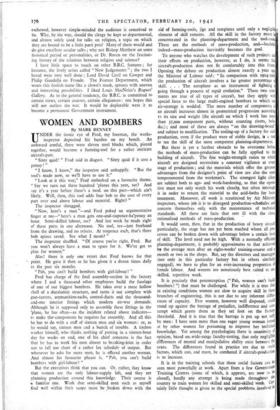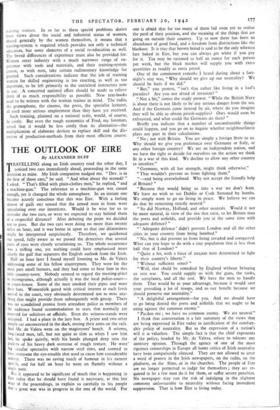WOMEN AND BOMBERS
By MARK BENNEY
UNDER the ironic eye of Fred, my foreman, the works- inspector deposited his burden on my bench. An awkward armful, there were eleven steel blocks which, pieced together, would become a forming-tool for a rather intricate aircraf t-part.
" Sixty quid! " Fred said in disgust. " Sixty quid if it cost a penny! "
" I know, I know," the inspector said unhappily. "But the tool's made now, so we'll have to use it."
" Look at it this way," Fred embarked on a favourite theme. " Say we turn out three hundred 'planes this year, see? And say it's a year before there's a mod. on this part—which ain't likely. Well, then, this tool adds four bob to the cost of every part over and above labour and material. Right? "
The inspector shrugged.
" Now, here's a man "—and Fred poked an argumentative finger at me—" here's a man gets one-and-sixpence-ha'penny an hour. Semi-skilled labour, see? And last week he made eight of these parts in one afternoon. No tool, see—just freehand from the drawing, and no rejects. At tenpence each, that's three bob apiece saved. See what I mean? "
The inspector shuffled. " Of course you're right, Fred. But you won't always have a man to spare for it. We've got to plan for women."
Alas! there is only one retort that Fred knows for that - point. He gave it then as he has given it a dozen times daily in the past six months.
" Pah, you can't build bombers with girl-labour! "
Fred has charge of the final assembly-section in the factory where I and a thousand other employees build the fuselage of one of our biggest bombers. He takes over a mere hollow shell of a duralumin structure, and turns it out complete with gun-turrets, ammunition-racks, control-ducts and the thousand- and-one interior fittings which modern air-war demands. Although he is supposed only to assemble these fittings in the 'plane, he has often—as the incident related above indicates— to make the• components he requires for assembly. And all this he has to do with a staff of sixteen men and six women: or, as he would say, sixteen men and a bunch of trouble. A tireless worker himself, who thinks nothing of putting in a sixteen-hour day for weeks on end, one of his chief concerns• is the fact that he has to work his men almost to breaking-joint in order not to fall too short of a rather lax schedule of output. But whenever he asks for more men, he is offered another woman. And almost his favourite phrase is, " Pah, you can't build bombers with girl-labour! "
But the executives think that you can. Or, rather, they know that women are the only labour-supply left, and they are planning production around this knowledge.• Their course is it familiar one. Work that semi-skilled men such as myself find well within their scope must be broken down with the
aid of forming-tools, jigs and templates until only a negligi element of skill remains. All the skill in the factory must concentrated in the planning-department and the tool-r These are the methods of mass-production, and—lauda indeed—mass-production inevitably becomes the goal.
To anyone who watches the development of such projects an their effects on production, however, as I do, it seems thz aircraft-production does not fit comfortably into this frank Opening the debate on production almost exactly a year age, the Minister- of Labour said: " In comparison with 1914-19k the production of aircraft involves a far greater percentage a skill. . . . The aeroplane as an instrument of fighting going through a process of rapid evolution." These two state• ments are true of all types of aircraft, but they apply will special force to the large multi-engined bombers to which our air-strategy is wedded. The mere number of components r an aircraft increases almost in geometrical progression according to its size and weight (the aircraft on which I work has mar: than 57,000 component parts, without counting rivets, bolt &c.) ; and most of these are always " on the drawing-board" and subject to modification. The tooling-up of a factory for suc production, even if the product were of stable design, is a task to tax the skill of the most competent planning-department But there is yet a further obstacle to be overcome before the methods of mass-production can be fully applied to the building of aircraft. The fine weight-strength ratios to which aircraft are designed necessitate a constant vigilance at even stage of production ; and the materials which offer the greatest advantages from the designer's point of view are also the most temperamental from the workman's. The strongest light alloys are subject both to age- and work-hardening, so that the opera- tive must not only watch his work closely, but often interrupt it in order to return the material to the acid-baths for heat• treatment. Moreover, all work is scrutinised by Air Ministry inspectors, whose job it is to disregard production-schedules and concern themselves only with the maintenance of technical standards. All these are facts that sort ill with the close, rationalised methods of mass-production.
It would seem, then, that in the production of heavy aircraft particularly, the stage has not yet been reached where all pro- cesses can be broken down with advantage below a certain level of skill. The level need not be high. With a normally efficient planning-department, it probably approximates to that achieved by the average man after an eight-weeks' training-course and month or two in the shops. But, say the directors and managers (not only in this particular factory- but in others similarly engaged), we have to plan for an ever-increasing proportion of female labour. And women are notoriously best suited to an• skilled, repetitive work.
It is precisely that preconception ("Pah, women can't build bombers! ") that must be challenged. For while it is true that in existing conditions women are slow to acquire skill in these branches of engineering, this is not due to any inherent differ• ences of capacity. Few women, however well disposed, could stand up against the barrage of prejudice, indifference and con' tempt which greets them as they set foot on the factory threshold. And it is true that the barrage is put up not ooll by men: I have seen more than one eager young woman jeered at by other women for presuming to improve her technical knowledge. Yet among the psychologists there is unanimity 01 opinion, based on.wide-range faculty-testing, that only negligible differences of mental and manipulative ability exist between the sexes. The differences found in practice are due to social factors, which can, and must, be combated if aircraft-production is to increase.
It is in the training schools that these social factors can be seen most powerfully at work. Apart from a few Government Training Centres (some of which, it appears, are now to be closed), hardly any attempt is being made throughout the country to train women for skilled and semi-skilled work. Ca' tainly little thought is given to the special problems_iavolved is
training women. In so far as these special problems derive from views about the social and industrial status of women, shared generally by the women themselves, it means that a training-system is required which provides not only a technical education, but some elements of a social re-education as well. The broad differences of experience must also be provided-for. Women enter industry with a much narrower range of ex- perience with tools and materials, and their training-system cannot, as with men, take certain rudimentary knowledge for granted. Such considerations indicate that the job of training women for skilled engineering is too exacting, as well as too important, to be left primarily to the untrained instructors now in use. A concerted national effort should be made to relieve them of as much responsibility as possible. New text-books need to be written with the woman trainee in mind. The radio, the gramophone, the cinema, the press, the specialist lecturer, all need more serious employment than they have yet received.
Such training, planned on a national scale, would, of course, be costly. But even the rough economics of Fred, my foreman, reveal that it would be less costly than its alternative—the multiplication of elaborate devices to replace skill and the dis- tortion of production-methods from their most efficient course.



























 Previous page
Previous page